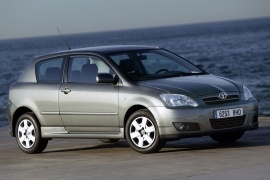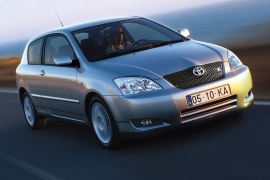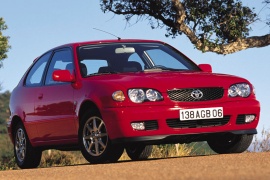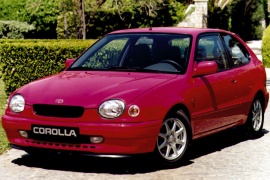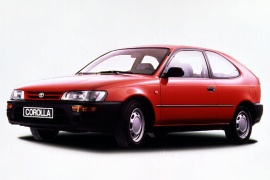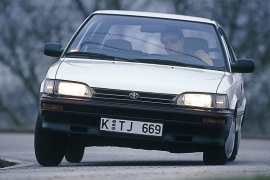TOYOTA Corolla 3 Doors Models/Series Timeline, Specifications & Photos
First production year: 1987
Engines: Diesel, Gasoline
Body style: Hatchback
The Corolla reached its ninth generation in 2000. In 2004, the car-maker introduced the 3-door hatchback version for the European market with a sporty look.
With the new model on the market, the Corolla 3-door had to fight against the best of the compact class vehicles in Europe, such as the VW Golf, Renault Megane, Opel/Vauxhall Astra, and Ford Focus. Another important contender on the market also was the Honda Civic 3-door. In 2004, Toyota had to do a facelift to improve the compact Corolla, which was lower on the sales by all of the above.
Since there was little to do with the exterior look, the Corolla 3-door was improved in the technical department. The new smoked headlights and a reshaped bumper aimed for a sportier look. But the rest of the greenhouse, with more upright windshield than the other contenders, didn't help.
Inside, the Corolla was fitted with an option for sportier-look seats, but without big bolstering on the side to help while fast cornering. The simple layout of the dashboard was not as bold as those offered by the other competitors. Toyota's design philosophy was not so appealing for European customers.
In the technical department, the Corolla 3-doors offered economy engines of 1.4-liter diesel and went up to a 1.8-liter unit that offered 192 hp for the European version. In other markets, it was available with a supercharger that boosted the power output up to 225 hp. That was not available in Europe.
TOYOTA Corolla 3 Doors 1.4L VVT-i 5MT FWD (97 HP)
TOYOTA Corolla 3 Doors 1.6L VVT-i 4AT FWD (110 HP)
TOYOTA Corolla 3 Doors 1.6L VVT-i 5MT FWD (110 HP)
TOYOTA Corolla 3 Doors 1.8L VVTL-i Sport Compressor 6MT FWD (218 HP)
TOYOTA Corolla 3 Doors 1.8L VVTL-i Sport Compressor 6MT FWD (225 HP)
Since its introduction on the market in 1968, the Toyota Corolla suffered many mechanical and exterior design changes.
Offered in different body styles such as a hatchback, a coupe, a wagon and a sedan, the Corolla enjoyed great success mostly due to its reliability.
With many competitors in the segment, Toyota decided to reveal a more modern Corolla to compete with the Ford Focus, the Honda Civic and the Hyundai Elantra.
Under the hood, the Corolla was fitted with a punchy and smooth-revving 1.8-liter 4 cylinder unit that developed 125 hp. The powerplant was mated with a manual transmission, but an optional automatic 3-speed or 4-speed gearbox was available.
The 2002 model was available in three trim levels: the base CE, LE and the Sporty S.
Toyota was criticized for the lack of air-conditioning and power windows as standard features.
The upper trim level LE added a tilting steering wheel, power windows and a 60/40 split folding rear bench.
With the Sporty S trim level, the Corolla included body-colored rocker panels and door handles, fog lights, a fake leather-wrapped steering wheel and a tachometer with outside temperature display.
One of the biggest drawbacks was represented by the cramped interior, for both front and rear passengers.
With the rather bland exterior design, the Toyota Corolla was the choice of the people looking for the “run-forever” reputation.
Toyota refreshed the eighth generation of the Corolla in 2000 and finally created a common design language for the entire family of this nameplate.
The Corolla was the best-selling car for Toyota, and it created a different front fascia for the three-door version than for the rest of the family. But customers didn't seem to enjoy that. In addition, that idea created more logistical troubles for the spare parts department. So when it saw that all of its efforts were in vain, the Japanese automaker unified the lineup's look along with the facelifted version that occurred in 2000.
The three-door Corolla looked more tamed, sporting horizontal headlights that still followed the already-gone bio-design trend. It might have loose some of its daring look offered by the big round headlamps from the non-facelifted version, but it was more acceptable for its customers. On the other hand, the profile remained the same with the large window behind the doors and the raked-forward tailgate.
Inside, the car sported a new dashboard that included a redesigned upper area above the center stack. There was also a new steering wheel, and most versions got a dual-airbag system fitted as standard. Yet, the seats were still not that bolstered. After all, it was not exactly a hot hatch of any sort.
Under the hood, Toyota installed a small range of engines consisting of a 1.6-liter gasoline unit and two diesel versions: a 1.9-liter carried over from Peugeot-Citroen, and a 2.0-liter turbo-diesel developed in-house.
Already famous for their great reliability and excellent value for money, the Corolla range was updated in 1997.
Guiding their evolution process on the “If it’s not broken, don’t fix it” idea, Toyota managed to keep Corolla’s position on the market, thus it was awarded the world’s best selling car title in 1997.
The 3-door hatchback was upgraded along with the 5-door liftback, the estate and the saloon body styles.
A world car, the Toyota Corolla was sold in three different markets: Japan, North America and Europe.
While the previous models were greatly appreciated, Toyota noticed the customer’s need of a more fun-to-drive vehicle, thus excitement needed to be a word to define the new generation.
The new models came with a changed suspension, new fabrics inside, more lively design elements and a heavily redesigned exterior look, with revised headlights, a new grille and new taillights. The redesigned exterior also helped reducing the NVH levels with its flush-mounted side windows and other techniques borrowed from Lexus.
Other changes included new technical specifications and well as more equipment.
Both gasoline and diesel units were available, however, the Japanese market had a broader range of engines to choose from. Most Corollas were powered by a 1.8-liter all-aluminium DOHC 4-cylinder engine that developed 120 hp and 122 pound-feet of torque. Besides more power offered, the engine helped achieving a lower fuel consumption than its predecessor.
Concerned about safety, Toyota offered the Corolla with four-wheel antilock brakes and side-impact airbags.
Toyota introduced the seventh generation of the Corolla in 1992, and it offered it in several bodywork versions so that it could target more customers.
While the station wagon was mainly developed for families, the three-door hatchback targeted the young generation or those who didn't have children. Yet, despite the car's sporty look, it was fitted only with fuel-efficient engines that couldn't provide the same thrills as other European carmakers.
With a front fascia that didn't inspire too many people, the three-door Corolla struggled to stay alive on the market. Its slim grille and bland styling were not that attractive. In addition, the corner-mounted turn signals exposed them to small parking bumps and shopping carts. On the other hand, the profile was rightfully made with a slightly ascending beltline and a raked-forward C-pillar. Moreover, the blackened slim B-pillar made it look even sportier. Still, the back of the vehicle with its narrow and rectangular taillights was a far cry from what the hot-hatch segment buyers were looking for.
Inside, the three-dial instrument cluster didn't feature a tachometer for the base versions but was available at extra cost or standard for the upper trim levels. The rounded shape of the dashboard and the driver-oriented center stack were good ideas, but there was nothing to write home about it. And yet, it could accommodate up to five passengers if those in the back were very close friends.
Under the hood, Toyota tried to convince people with a range of fuel-efficient engines ranging between 75 hp and 114 hp. At the same time, the competitors already offered over 140 ponies for the same price.
In the mid-80s, Toyota raised the bar and changed the game, noticing people’s desire: a car that would do more than just taking its occupants from A to B.
The new Corolla came to life under the newly promoted development leader Akihiko Saito’s supervision. His vision was pretty simple and complex at the same time, as he stated to his team: “I believe that the Corolla must erase the image of family cars of the past. Wouldn’t it be nice if the quietness and ride comfort of the Crown and the attractive appearance of the Mark II were achieved in a vehicle the size of the Corolla?”
With this idea in mind, the team focused on developing a powerful design regardless of the body style, while the new Corolla also had to be fun to drive.
Aesthetically, the new Corolla was wide and low, with more rounded edges compared to the previous generations. To give the impression of a luxurious vehicle, the A and C pillars were pulled closer together.
Toyota considered people’s opinions regarding interior design. Thus, they asked their customers to better understand what they were looking for: a note of luxury and increased comfort. The Corolla featured velour and thick-knitted fabric materials. Optionally, customers could choose a maroon interior color scheme that was rather seen in the most luxurious vehicles of the time.
All controls allowed easy operation, while Toyota gave great attention to the switches' feel, besides the overall well laid out instruments.
The NVH levels were considerably low; thus the Corolla felt very refined.
All body styles available were offered with a front-wheel-drive system, which was rather unusual for Toyota, as their previous generations mostly featured a rear-wheel-drive system.
